- Read about the evolution of Mother Goddesses from pre-historic times including thoughts on Tantra and Shakti-worship.
In all ancient cultures
or primitive societies women formed to be the foundation pillars upon whom
rested the important tasks of giving birth and rearing the young, while
teaching them what were seen as social norms, culture-heritage, behavioral
habits, and traditions of those times. The women were seen as life producers
with regenerative capacities, hence her organs that helped in procreation
became the symbols of new life, and motherhood became the core figure in
magico-religious cults of those times.
The Paleolithic female
figures found in abundance from various excavation sites with exaggerated
maternal organs, stand as an evidence, showing the popularity of Mother Goddess
worship in prehistoric times; a practice still popular in India, in a more developed
form of worship of the Sakti or the feminine principle.
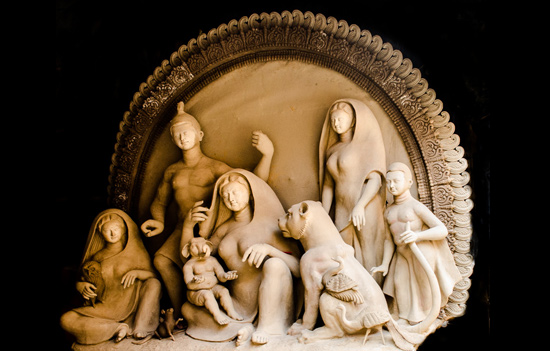
A regular supply of food and offspring would have been the most important requisites of the primitive society, thus one can assume that preservation of life would be at the core of any prehistoric religious cult. As a general norm it is seen that the way of life of a group of people tend to define the basic framework for the type of deity and manner of worship in that group. From hunter gatherers, as the primitive society moved towards food production or farming, the regular food (hunted or farmed) acquired a high degree of importance and sacredness, and it was likely that the women’s capability of procreation got associated with the plants and animals that kept the society nourished in ancient times.
Thus, the primitive
mother goddess figures (from Middle and Upper Paleolithic times) that we see
with grossly exaggerated sexual organs, initially would have been part of some
fertility rituals asking for greater production of game and human offspring.
During the Neolithic
times as the society slowly moved towards agriculture, the religious beliefs
started adding agricultural rituals alongside the hunting ones that were
already in practice. The graves found in the upper paleolithic sites across the
world held skeletal remains with bones that were reddened using ochre, along
with food, tools, weapons, and ornaments. Red being the colour of regeneration,
and foetal positions of the skeletons tend to point to a belief that the soul
or body would regenerate (a rudimentary concept of re-birth) and start a new
life again.
However, Neolithic graves
show some changes, and the visibly greater pomp and reverence in laying
down the body under the earth, pointed at a changed belief where the body was
believed to affect the crops that sprung forth from the Mother Earth.
Thus, during the
Neolithic times the Mother Goddess was not just a life creating mother, she was
also the Mother Earth from whom the crops sprung, and who like any other woman
could also be influenced with gifts and entreaties and allow herself to be
controlled through various rituals and rites.
Across all neolithic
cultures spread across Egypt, Mediterranean, Syria, Iran, and parts of SE
Europe, female figurines in bones, stones, or clay have been found that are
said to be the direct descendants of the images of deities created by the older
Mesopotamia, Syrian, and Greek societies.
“The Paleolithic
Era (or Old Stone Age) is a period of prehistory from
about 2.6 million years ago to around 10000 years ago. The Neolithic
Era (or New Stone Age) began around 10,000 BCE and ended between 4500 and 2000 BCE in various parts of the world. In the Paleolithic era, there were more than one human species but only one survived until the Neolithic era. Paleolithic humans lived a nomadic lifestyle in small groups. They used primitive stone tools and their survival depended heavily on their environment and climate. Neolithic humans discovered agriculture and animal husbandry, which allowed them to settle down in one area.” Source
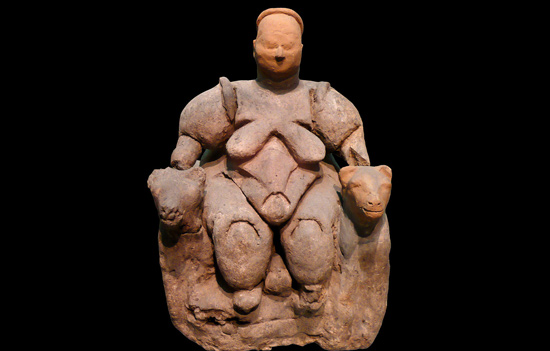 Seated Mother Goddess of Çatal Höyük: the head is a restoration, 6000 BCE- Neolithic era. Museum of Anatolian Civilizations
Seated Mother Goddess of Çatal Höyük: the head is a restoration, 6000 BCE- Neolithic era. Museum of Anatolian Civilizations
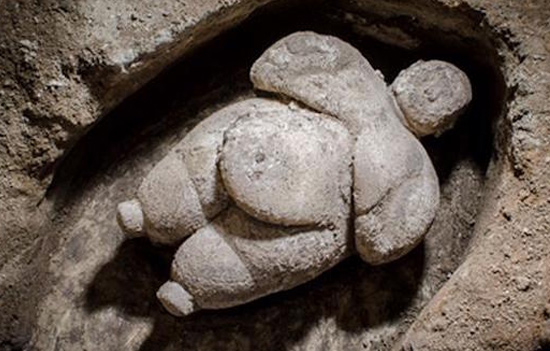 This figurine was discovered at the Neolithic site of Çatalhoyuk in Turkey.
This figurine was discovered at the Neolithic site of Çatalhoyuk in Turkey.
More on caption - It was carefully buried beneath a platform in a house, along with a valuable piece of obsidian. Made of marble, it’s nearly 7 inches long. Source
Paleolithic era of the
Old Stone Age is correlated with food gathering or Hunting societies/economy;
while Neolithic era roughly relates to the transition from food gathering
to food producing societies, though the latter has no uniform time frame in
terms of the economy.
This is especially so in
India, hence it is more logical to focus on the
anthropological categorizations, which can be better identified and
recorded from among the different surviving Indian tribes (many of whom were
still following the prehistoric customs until very recently).
From a study of the
existing Indian tribes three main types that had been derived are: hunting-food
gatherers, pastoral, and agricultural.
However, the three are not mutually exclusive, nor do they have any strict
chronological order. So often we find pastoral communities that practice
agriculture along with stock raising, and agricultural communities that indulge
in stock raising along with farming. Regarding the cults and rituals followed
by the food gatherers and agricultural societies, the worship of mother goddess
was at the core of all their magico-religious beliefs.
However, the pastorals
had a very different way of living, and they endured greater hardships in their
daily lives. The pastorals were more dependent on a good leadership to protect
their cattle, and this in turn gave rise to the development of the cult of
heroes and ancestors who were worshiped and highly revered by the members of
this community. Since the pastorals spent a large time under the open skies and
endured the wrath of the nature in form of storms, harsh sun, or heavy rains,
their gods were inevitably connected to the sky in which nature and astral
objects were personified as gods. The Supreme God of the pastorals is thus a
man who leads and protects them, much like the head man of a joint patriarchal
family. On the other hand, agricultural societies who are dependent on the
earth to produce their crops developed the worship of feminine energy and the
cult of Mother Goddesses, which involved rituals related to fertility and
magic.
Mother Goddesses and fertility
The concept of Mother Goddess and associated fertility
rituals is the most primitive and longest surviving religious practices in the
world. The belief that women can multiply crops and fruits because they can
create children out of their bodies was universal across all ancient societies.
Thus, came the belief that what is sown or planted by a pregnant woman will
also grow to bear fruits much like the child in her womb, while a barren woman
will make the fields barren too.
As per the prehistoric thinking, women, who were also the first cultivators, with their child bearing capabilities would create a similar effect on the earth’s vegetative powers leading to good harvests, and thus women were seen as repositories (storeroom) of agricultural magic. In prehistoric era people would apply their own experiences from life to the various things that they saw around them, which is now known as principle of analogy.
Thus, natural productivity was compared to human
procreation capability, and earth mother or the mother goddess was
conceptualized from a human mother. There are innumerable such examples from
old Indian literature. Almost all the Puranas and Smritis (law books for
various sects) have the line Ksetra-bhuta smrta nari vijabutah smrtah
puman, where kshetra (seed-field) refers to woman (woman is mentioned as a
seed field also during the marriage ceremonial rites), and a man is identified
as the seed. This likening of the woman to the field or earth means that the
functions of the two are the same, with the belief that conditions that lead to
a woman becoming fertilised applies also to the Earth. The same belief
continues in the ritual known as ambuvaci (observed on and
from 7th day of the third month of the Hindu calendar). It is believed that
that during the four days of the ritual the Mother Earth also bleeds to prepare
for fertilization. All kinds of agricultural work like ploughing, sowing etc,
are suspended at this time so that Mother Earth can rest during her
menstruation (also refer to the rituals of Kamakhya devi in Assam during ambuvaci).
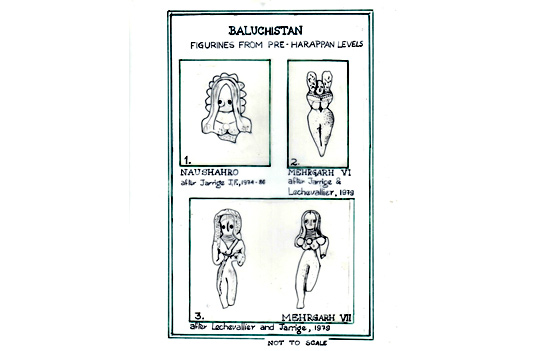 The Zhob and Kulli sites in north and south
Baluchistan have yielded many such terracotta figurines.
The Zhob and Kulli sites in north and south
Baluchistan have yielded many such terracotta figurines.
More
on caption- And these represent the earliest embodiment of the primitive Mother
Goddess figures in the Indian subcontinent. photo Source
The tantric form of worship also lays special
importance to the menstrual blood for the same reason. Here in comes the use of
the color red/vermilion, which we see being used in almost all Indic religious
traditions. The Bhil tribes before sowing
their fields followed the traditions of setting up of a stone smeared with
vermilion. Since vermilion or red colour symbolises the menstrual blood, the
smearing of vermilion implies the passing of the energy of
procreation to the earth and making it fertile.
The Mohenjodaro Mother
Goddesses mostly have a red slip or wash paint over them, as are the Venus
figures of Willendorf (Austria). Briffault who connected the red color with
menstrual blood and fertility further said that in many countries across the
world it was an ancient custom for pregnant or menstruating women to colour
their bodies with red ochre in order to improve their chances of fertility and
also to keep off men during those times. The same tradition is still seen in
Hindu women who wear vermilion (sindoor) after marriage, signalling their
bindings to one man and the readiness to procreate. For the same reason widows
and unmarried girls cannot use sindur, because they cannot procreate. Holi,
which is also a ritual of fertility, originally showed the profusion of colour
red.
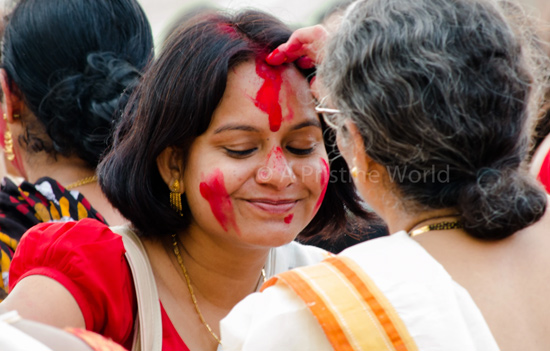 The vermilion or sindur on the forehead and hair
parting signals that the woman is married.
The vermilion or sindur on the forehead and hair
parting signals that the woman is married.
In Tantric form of
worship the focus remains on the rituals centering around female genitals (lata
sadhana), and the tantric yantras that symbolise female organs.
During Durga puja a
yantra known as sarvatobhadramandala symbolising the female
procreation organs is drawn on the ground in the form of alpona. Then a
purnaghata or a purnakumbha symbolizing the womb is placed on it and
sindurputtali or the figure of a baby is drawn on the ghata, and finally
five leaves or amrapallava is placed on the ghata with a sindur smeared coconut
on top. This is thus a simple fertility ritual that connects female
regenerative powers of both humans and plants (human and natural fertility) to
ensure continual procreation.
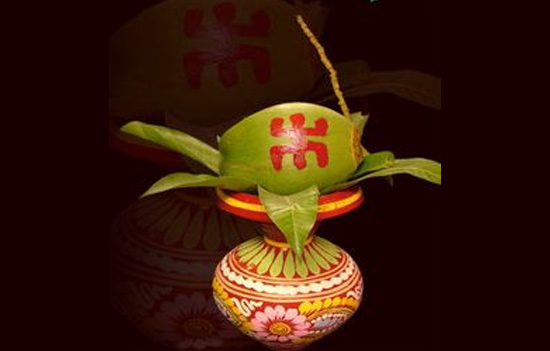 Purnaghata with the five leaves and coconut on top, denoting a fertility ritual. (pic from internet)
Purnaghata with the five leaves and coconut on top, denoting a fertility ritual. (pic from internet)
That the yantra and
purnaaghata is associated with fertility is best depicted in the murti of
a mother goddess found on the hilly slopes facing the river Krishna in
Nagarjunakonda. It depicts the lower part of a female figure in a sitting or
squatting position with legs doubled up and set wide apart and the feet
facing outwards. The bifurcated part prominently shows the vulva or the yoni-
dvara, and the ornamented broad belt or girdle (mekhala) from below the
naval creates a purna-ghata like imagery. Satapatha Brahmana equates
a purnaghata with the mother goddess; while Kathasaritasagar is
more detailed in its comparison of the purnaghata with that of a womb.
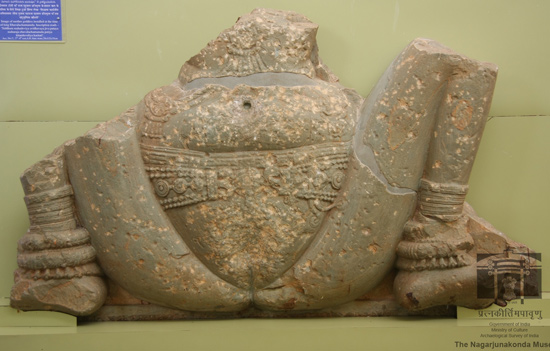 The Mother Goddess from Nagarjunakonda, 3rd c. CE
The Mother Goddess from Nagarjunakonda, 3rd c. CE
Full caption- The Mother Goddess from Nagarjunakonda, 3rd c. CE. “There is a single line Prakrit Inscription in Brahmi characters of third century AD engraved on the narrow strip of space at the bottom of the sculpture (partly covered by the pedestal). It records that the figure was caused to be made by Mahadevi Khamduvula who was an avidhava (whose husband was alive) and a Jivaputa (whose sons were alive) and whose husband is Maharaja Siri Ehuvula Chamtamula. This peculiar iconic form, typical of the Deccan, even in terracotta medium, represents a widely prevalent fertility cult associated with conference of longevity to the lady worshipper’s husband and offspring’s as attested by the inscription too“. Text
and Photo Source
Post Script: the concept and development of Mother Goddess worship across all the ancient civilizations is a long topic and cannot be covered in one such post. I will try to write more on this topic in some of my later posts, and one topic that I particularly wish to take up is the concept of ‘sacred prostitution’ or the ‘devadasi pratha’ that was once a part of this mother goddess worship cult and seen commonly across all the ancient civilizations.
References
1. Agarwala, PK, Goddesses in Ancient India,
1983.
2. Briffault, R. The Mothers, 1952.
3. Bhattacharya S., Tantra Paricaya (Bengali),
1952.
4. Bhattacharya, NN, Indian puberty rites,
1980.
5. Banerjea, Development of hindu iconography
To read all
articles by author
Author studies
life sciences, geography, art and international relationships. She loves
exploring and documenting Indic Heritage. Being a student of history she likes
to study the iconography behind various temple sculptures. She is a well-known columnist
- history and travel writer. Or read here
Article was first published on author’s blog and Here
Article and pictures are courtesy and copyright author.